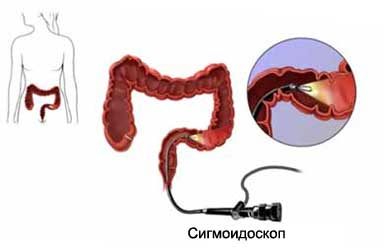Flexible sigmoidoscopy – Flexible Sigmoidoscopy
Description flexible sigmoidoscopy
Flexible sigmoidoscopy is a visual inspection of the rectum and lower colon (colon). Inspection is carried out with a tool, called flexible sigmoidoscopy. Sigmoidoscope is a flexible tube with a tiny camera on the end. This instrument allows the doctor to see the rectum and colon.

Reasons for flexible sigmoidoscopy
Sigmoidoscopy is used to test and diagnose problems in the rectum and lower colon. This procedure is most often done, that:
- Obtain tissue samples for testing;
- Identify causes of rectal bleeding, diarrhea, constipation, abdominal pain, or inflammation;
- Detect the presence of or remove polyps (small growths, which can go into cancer);
- To monitor the response to therapy, if you have inflammatory bowel disease;
- Detect Colorectal Cancer.
Possible complications of flexible sigmoidoscopy
Complications are rare, but no procedure does not guarantee the absence of risk. If you plan a sigmoidoscopy, you need to know about possible complications, which may include:
- Bleeding;
- Perforation or puncture of the bowel wall;
Factors, that may increase the risk of complications:
- Existing heart disease or kidney disease;
- Treatment with certain drugs, including aspirin and other drugs with anticoagulant or blood-thinning properties;
- Surgery in the abdominal cavity or radiation therapy.
How is a sigmoidoscopy?
Preparation for the procedure
Consult your doctor about the drugs taken. A week before surgery you may be asked to stop taking some medicines:
- Aspirin or other anti-inflammatory drugs;
- Blood thinners, such as clopidogrel (Plaviks) or warfarin;
- Iron supplements or vitamins, containing iron.
Your colon must be completely clean before the procedure. Any chair, which remains in the intestine will block Review. This preparation may start several days before the procedure,. Follow your doctor's instructions, which may include any of the following ways to clean:
- Enema – rectum liquid introduced, to stimulate defecation;
- Laxatives – Take your medicines, that stimulate chair;
- We need to take a clear liquid diet;
- Drinking a lot of fluid stimulates defecation;
- On the eve of the procedure in the evening you can eat a light meal. Do not eat or drink anything after midnight;
- Wear comfortable clothes.
Your doctor, probably, perform these steps::
- Do a physical and rectal examination;
- Studying the history of the disease;
- Learn about the medication;
- Hold fecal occult blood test.
Anesthesia
The doctor provides sedatives, to reduce discomfort.
Procedure Flexible sigmoidoscopy
You will lie on your left side with legs bent and knees pulled up to his chest, on a table or chair. Try to relax, Breathe slowly and deeply. Doctor, Firstly, hold your finger rectal examination. Then lubricated sigmoidoscope will be slowly inserted into your rectum. Sigmoidoskopa thickness approximately equal to the thickness of a human finger. The device will be slowly injected through the line into the colon. Also through the air can be supplied sigmoidoscope, for opening the colon and for, to examine in more detail the intestinal wall.
A small video camera on the end of the sigmoidoscope allows the doctor to examine the colon cover, projected on the screen.
During the procedure, can be selected tissue samples for biopsy or polyps removed.
How long will the flexible sigmoidoscopy?
The procedure usually lasts about 20-30 minutes.
Will it hurt?
Most people report some discomfort, When the device is inserted. During the procedure, you may feel cramping, muscle cramps or abdominal pain. You may also feel the urge to have a bowel movement. Tell your doctor, if you feel a lot of pain.
After the procedure, the common muscle spasm and pain from gas injected. These pains should go away after the gas.
Caring for the patient after flexible sigmoidoscopy
If the fabric has been removed:
- It will be sent to a lab for examination. It may take 1-2 of the week. Depending on the results obtained may be recommended other tests;
- During the first few days after the procedure may be a little bleeding.
When you return home after the procedure, Follow your doctor's instructions, which may include:
- Resume taking medicines as directed by your doctor;
- You can resume a normal diet, unless otherwise stated Dr..
Ask the doctor, when you can go back to work. Sedative give you a feeling of sleepiness. Avoid driving, control equipment or make important decisions until the end of the day.
Contact your doctor after flexible sigmoidoscopy
After returning home, you need to see a doctor, If the following symptoms:
- Bleeding from the rectum. Tell your doctor, if allocated more than a teaspoon of blood;
- Black, tarry stools;
- Severe abdominal pain;
- Heavy defecation, constipation;
- Signs of infection, including fever or chills;
- Nausea and vomiting;
- Failure to pass gas or stool;
- Chest pain or shortness of breath.
